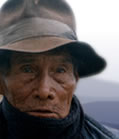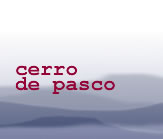 |
 |
||
 |
|||
|
RELATED THEMES agriculture culture and customs development health history livestock OTHER LOCAL THEMES BACKGROUND |
traditional skills
Cerro de Pasco clearly underwent considerable change as the mining industry came to dominate many people's lives, and attracted outsiders and different customs to the region. Improved transport links, access to the media and to education, and the influence of people returning from long periods spent working in Peru's towns and capital city, have also brought new ways of doing things. Yet the interviews are dotted with references to surviving local customs and traditional skills, especially the continued use of herbal remedies - for humans and animals. One woman recalls how her grandfather cured her husband of lung disease which he got from being a miner: "My grandfather cured him. He boiled them [four toads] and he made my husband drink quite a lot of it for a few days and so he made him quite well. He also gave him herbs. mulanca from higher up [the mountains], my husband also took that. Making a soup, he made him eat this as well, along with the concentrate of little animals, but he wouldn't tell him [what it was] because otherwise he wouldn't want to drink it. Poor thing, he would just drink it. He didn't like it but it helped him a lot and he got better like that" (Peru 13). Several narrators also mention people's skill in using local plants and other resources to treat livestock disease, but add that such remedies appear ineffective against the illnesses caused by pollution. Traditional foods, too, are still made and enjoyed. But the old crafts, especially those involving weaving and dyeing, are more usually mentioned in the context of a dying skill. The clothes and wall hangings made from the local wool were produced for a once thriving market - now, some narrators say, everyone wants things made from chemical dyes and synthetic material. "Earlier, we spoke mainly Quechua, we didn't use Spanish. And there was so much of what we call artisania, wool obviously, wool from the sheep, wool from vicuñas. These days nobody ever uses wool from vicuñas, not for shawls or anything, it's prohibited to wear a shawl from vicuña wool. Because the [authorities] banned it. Now you can't make anything and you have to buy things made in the cities" (Peru 8). quotes about traditional skills ".the judeo with a guinea pig, it's like a cure, that's what the judeo is, that's what it's called around here. Of course they still do it, now more than ever, it's our natural medicine, traditional. Yes, [we go to doctors] as well, but we also use our own cures with the guinea-pig and the coca as I told you. Coca helps us carry on, helps us to keep well. Coca is our companion." "The Yanahuanca.is where our customs and traditions are best kept. Even food, because most of the people of the highlands don't use much from other areas, things which have been prepared or put into jars. If you eat there they'll give you potato, beans, wheat, barley all made in different ways - local dishes. They also eat mashua, caya, chuño. The local dishes include locro, tocle made from pork crackling, chick peas, chuño, wheat, beans with little bits of charqui (dried llama meat)." "[There was] a very sour plant which my mother used to prepare by boiling in an oil. [It] is bitter and is used to get rid of worms. So, as I said, [my parents] use a lot of things, they use their ingenuity. For example. [my mother] collected some car grease, put copper sulphate into it and by mixing it and putting it on the sheep she cured the problem of the lice on the sheep's feet; it also cured the mange on the mouth." "Before we used to use our wool, sheep wool, alpaca wool, llama wool, for jumpers, and now we don't any more. Now it's all plastic and foreign dyes. Before I used to know the natural dyes, from plants, which were hard to fade. Now everything's plastic and the dyes all synthetic, synthetic wool which has to be used for jumpers and there's no real wool now, now there's no wool. Very occasionally they still use lambs wool but quite frankly it's looked down on these days." |
|